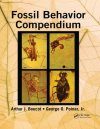By: Arthur James Boucot(Author), George O Poinar, Jr.(Author)
391 pages, 4 plates with colour photos; 285 b/w photos and b/w illustrations, 40 tables
![Fossil Behavior Compendium Fossil Behavior Compendium]()
Click to have a closer look
About this book
Contents
Customer reviews
Related titles
Recommended titles
About this book
Paperback reprint of a book published in 2010.
In this complete and thorough update of Arthur Boucot's seminal work, Evolutionary Paleobiology of Behavior and Coevolution, Boucot is joined by George Poinar, who provides additional expertise and knowledge on protozoans and bacteria as applied to disease. Together, they make the Fossil Behavior Compendium wider in scope, covering all relevant animal and plant groups and all epochs, and providing a detailed review of animal and plant fossil behaviour in terrestrial and aquatic environments.
Fossil behaviour encompasses not only past evidence of the life history of an organism but also behavioural, predation, and symbiotic interactions, including parasitism. This book compares patterns of behaviour and coevolution in the past with those of the present-day descendants. It also discusses how to evaluate the rates of evolution of behaviour and coevolution at various taxonomic levels. The compendium emphasizes the interactions between fossils and compares these interactions with present-day counterparts. It also provides new discussions on topics related to fossils in amber.
Keeping Boucot's trademark, easy-to-read style, the book includes new findings never published previously, reports not easily accessed, numerous examples, 40 tables, 285 illustrations – some published here for the first time – and a four-page colour insert. Fossil Behavior Compendium provides a concise account of the evidence for varied disease types recognized to date in the fossil record.
Contents
- Functional Morphology
- Specialized, Potentially Interacting Biological Substrates
- Mutualism
- Host–Parasite and Host–Parasitoid Relationships and Disease
- Density and Spacing
- Predation and Feeding Behaviors
- Communication
- Trace Fossils and Their Formers
- Specialized Substrates
- Sexual Behavior
- Parental Care
- Depth Behavior
- Phoresy
- Carrier Shells
- Pollination Ecology
- Social Insects
- Long-Range Migration
- Molting
- Sensitive Plants
- Reptilian and Mammalian Burrows and Dens
- Vertebrate Endocranial Casts
- Preening
- Grain-Size Selectors
- The Seagrass Community Complex
- Shelter
- Flying and Gliding Vertebrates
- Possible Genetic–Developmental Defects
- Teratologies
- Disease
- Marine Molluscan Larval Types and Their Behavior
- Competition Involving Bryozoans
- “Lost” Behaviors and Their Vestigial Evidence
- Stunting
- Oceanic vs. Neritic
- Human Behavior
- Summary and Conclusions
- References
Customer Reviews
By: Arthur James Boucot(Author), George O Poinar, Jr.(Author)
391 pages, 4 plates with colour photos; 285 b/w photos and b/w illustrations, 40 tables
"[...] a unique contribution to paleobiology, containing an overwhelming amount of detailed data on the inferred and actual behavior of virtually every group of organisms preserved in the fossil record [...] beautifully illustrated with hundreds of photographs and drawings of individual specimens [...] the authors have produced a tremendous contribution to modern paleontology."
– Edward Peteuch, Florida Atlantic University, author of Cenozoic Seas: The View from North America
" [...] an impressive collection of fossil material and literature [...] This work takes paleobiology from a record of the succession of fossil taxa through time (certainly important to answering questions about evolution) to a much more exciting representation of changes in whole communities and ecosystems. [...] This book will contribute greatly to our perspectives on how integrated communities and ecosystems have developed through time."
– Timothy D. Schowalter, Department of Entomology, Louisiana State University




































